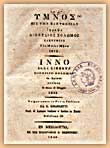 |

Solomos was born in Zakynthos in 1798. His father was a nobleman, whereas his mother came from the popular classes. After his first classes on the island, which were in Italian, he went to Italy in 1808. He stayed there for ten years, studied law at Pavia and came into contact with the intellectual movements of his time. The Italian poets - Ugo Foscolo in particular - influenced him decisively, and he started writing in Italian and Latin. In 1818 he returned to his birthplace, Zakynthos. He started becoming interested in the Greek language, for the study of which he sought popular works and simple language, the local poets and folk songs. He soon became familiar with the work of Christopoulos and Vilaras, the most conspicuous supporters of colloquial, popular language in the ongoing conflict within the framework of modern Greek Enlightenment. After his first efforts, in Greek this time, and under the influence of the rebellions of the Revolution which had already broken out in the Peloponnese and Central Greece, in May 1823 he wrote the Imnos is tin Elephtherian, (Hymn to Liberty), a poem of 158 stanzas, published in 1825. The first two stanzas of this poem were established as the National Anthem in 1865; the music for it was composed by Nikolaos Mantzaros. In 1824 he wrote an equally extended poem entitled Is ton thanato tou Lord Byron (Ode on the Death of Lord Byron). Thus began the poet's 'Zante period', one of his most creative. The War of Independence still constituted his main source of inspiration. A typical example of this is the Katastrophi ton Psaron (Destruction of Psara) in 1826. In this period he also wrote the first sketches for two of his most important poems, entitled Lambros (1823) and Eleftheroi Poliorkimenoi (Free Besieged) (1826). At the same time, however, he dealt with themes from everyday life. In Farmakomeni (Poisoned) of 1826, the subject is a girl's suicide, whereas in Gynaika tis Zakinthos (Woman of Zante), written between 1826 and 1829, with many subsequent elaborations, the dramatic situation of women refugees of Missolonghi is described, though not in the heroic style of his other contemporaneous works. During the same period, between 1823 and 1825, Solomos wrote the famous Dialogos (Dialogue), a text of literary criticism where he defends the use of simple everyday, colloquial language, against the supporters of archaizing language as well as the 'middle way' proposed by Korais. In 1828 the poet went to Corfu, where he stayed until his death in 1857. His first creation there was the ode Is Monachin (To a Nun) in 1829. Then in 1833-1834 came Kritikos (The Cretan), while in 1834 he published a part of Lambros. In these years he faced a serious family crisis which evolved into a long-lasting trial, where the opposing litigants were relations of his. Solomos's mature period was scarred by this event. For this reason he lost his creativity for a long period of time and only worked on sketches of Elephtheroi Poliorkimenoi (Free Besieged), a work which ultimately remained incomplete. Porphiras (The Shark), a poem inspired by a real event, where a shark (called 'porphiras' in the idiom of Corfu) tore an English soldier to pieces in the port of the island, also remained incomplete.
|


 |